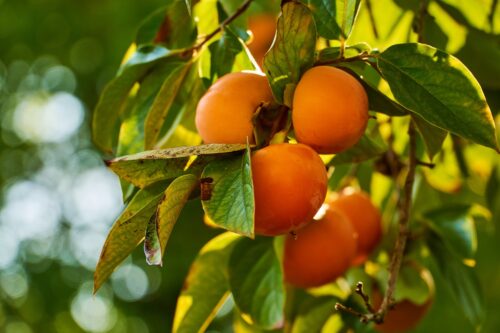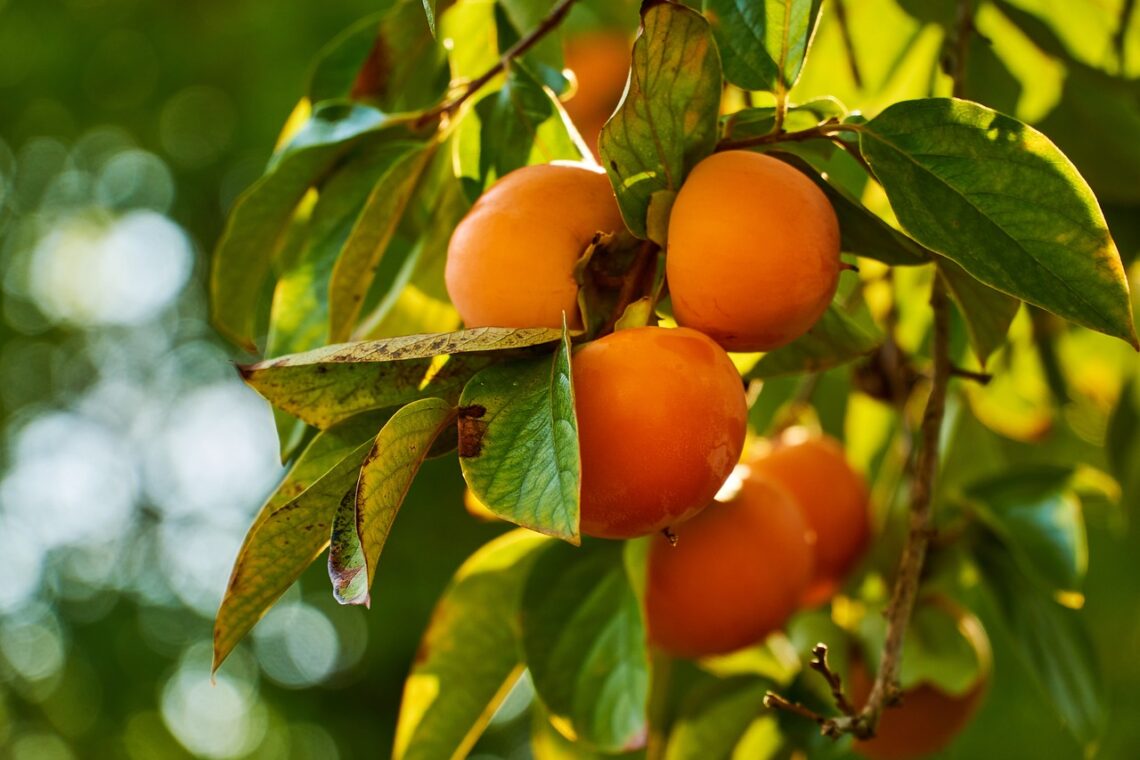Add a Persimmon Tree to your orchard. This ornamental tree requires little care and offers a large crop every year.
Native to Eastern North America, American persimmons (Diospyros virginiana) are cold-hardy and a great choice for beginner gardeners who can try growing them in spring after frost. The persimmon tree grows slowly and takes ten years to set fruit. Ripen fruit has a custard-like texture and a sweet taste like honey. This deciduous tree has blue-green foliage that turns yellow and orange during fall.
Persimmon or American Persimmon (Diospyros virginiana) is described as ‘food for the gods,’ though some people believe this Greek translation is not true. The fruit is small and bright orange and has an exceptionally energetic flavor when ripe, whereas unripe fruits are quite sour and inedible.
Commonly grown varieties are Asian or Japanese persimmon (Diospyros kaki). In the United States, the fruit is cultivated in warm states like Florida, California, and Texas.
It can reach 40-60 feet tall with a 20- 35-foot spread. In late spring, the tree produces white or pink flowers.
Botanical name: Diospyros virginiana
USDA Zones: 4-9
Persimmon Tree Varieties
Persimmon trees are divided into two main types: the American persimmon (Diospyros virginiana) and the Asian persimmon (Diospyros kaki). The American persimmon is known for being easy to cultivate and has various uses. The fruit is bright orange with a characteristic beak at the base, and it is generally smaller than the Asian persimmon. However, American persimmon fruit is astringent until it reaches full ripeness.
Asian persimmons, also referred to as Japanese or Chinese persimmons, come in two varieties. One type is astringent until fully ripe, similar to the American persimmon, while the other type is non-astringent and can be consumed while still firm.
Astringent fruit is consumed when it turns jelly-soft, whereas non-astringent is eaten when firm. Fuyu persimmon is a firm and common choice in the American palette. These fruits are a good source of potassium, fiber, and vitamins A and C. All American persimmon types are categorized as astringent.
Many fruit trees require warm weather to ripen; they get ready in the fall, mainly during September.
Note: To instantly ripen American astringent persimmons, keep the fruit in the freezer overnight. Remove the fruit from the freezer and let the cold-ripened fruit melt before eating.
Growing Persimmons in Pots

Growing persimmons in pots is a great solution for dealing with poor soil or cold climates. This method allows you to manage the soil quality and move the tree as needed. Additionally, potted persimmons are perfect for small gardens, thriving in limited spaces like a sunny corner of a porch or patio.
When planting persimmon trees, the first choice to make is between American and Oriental varieties. Despite a common misconception, American persimmons can be quite tasty, especially varieties like Prok, Yates, Early Golden, and Meader. Oriental persimmons, such as the well-known Fuyu, also yield excellent fruit. Many gardeners prefer to grow Fuyu persimmons in containers.
How to Plant Persimmon Trees?
Select a location with abundant sun and well-draining soil. Make sure the tree gets enough space to spread as it grows up to 50 feet tall. This tree has a strong, deep taproot, which is why it cannot grow well in pots. You can grow a persimmon tree from both seeds and cuttings.
Native persimmons require both male and female trees for fruit production. Female trees bear fruit only if there is a nearby male tree for pollination. In contrast, Asian persimmons are self-pollinating, which means a single tree can produce fruit. For those with limited garden space, an Asian persimmon is a more practical choice.
Ideal Growing Conditions for Persimmon Tree
Light
Full sun is a must for growing persimmon; afternoon shade is fine. Keep in mind about variable light patterns throughout the season, as persimmon ripen in late fall.
Soil
Persimmons prefer slightly acidic and loamy soil but adjust to various conditions. Avoid using salty soil and select an area with good drainage to prevent fungus and root rot.
Water
Once it reaches maturity, persimmons do not demand extra water except during unusually dry seasons. In drought, water once a week. After planting, this tree needs regular watering.
Temperature & Humidity
Diospyros virginiana can tolerate harsh winter conditions and temperatures up to -25 F. It is hardy to USDA zone 4. The tree enjoys some air circulation but does not plant persimmon in an area with a winter breeze.
Persimmon can withstand warm temperatures up to zone 9. It prefers moderate humidity and not fruit in desert climates.
Persimmon Tree Care
Fertilizer
This tree can live without supplementary fertilizer; it prefers loamy soil. Use very rich soil with amendments to give this tree a good start.
Pruning
Pruning the American persimmon properly in its early stage gives it a strong, healthy structure. After maturity, cut back any dead branches.
Also, you can prune the tree into a hedge or espalier form.
Pest and Diseases
Although persimmon is not susceptible to pests and diseases, ants and mealybugs can disturb this tree. To rescue the fruits, use organic methods.
Harvesting

Let the American persimmon ripen fully before harvesting. If grown from seeds, the female tree will bear fruit in 4-9 years, whereas grafted trees take three years. The fruit continues to ripen after picking. To enjoy a sweet flavor, allow them to turn entirely soft. The fruits become ready to harvest in late fall and stay on the tree into winter.



